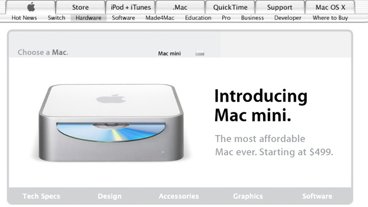Employees working the show floor of the Apple's developers conference last week could be overheard discussing the prospect of open-sourcing the company's WebObjects environment used for rapidly building and deploying web-based applications.
Upon its arrival at Apple, WebObjects was slowly nurtured and transformed into a 100 percent pure Java-based application server. With the release of WebObjects 5.0 in 2001, Apple dropped the cost of the software to a staggering $699.
That same year a company post to Apple's WebObjects mailing list read: "Now that WebObjects 5 is out, Apple is gearing up to promote WebObjects more aggressively." It never seemed to happen. If there were strides being made to get the word out on WebObjects, they were clearly overshadowed by other efforts at the company — mainly those focused on securing the fate of a lingering Macintosh platform.
Instead, Apple's focus on WebObjects remained largely internal. The software that once powered Dell’s online store was being used by Apple to run its own online business, which launched shortly after the NeXT acquisition. In latter years, WebObjects became the foundation of the now prominent and extremely successful iTunes Music service. But few external updates to WebObjects were being made available to the public and rumors implied that Apple had been furthering the development of the platform only for internal purposes.
Now four years later, with the Macintosh regaining popularity, Apple once again appears to be turning an external focus to the WebObjects platform. At last week's World Wide Developers Conference, the company announced a major upgrade to the software in WebObjects 5.3. Apple also announced that they were dropping the $699 licensing fee and instead would be distributing WebObjects free-of-charge along with Xcode 2.1, the newest release of its Macintosh development tools.
According to two independent sources on hand for the conference, Apple engineers discussing the future of WebObjects talked about open-sourcing the software. By opening WebObjects, Apple would make the documentation and source code of the software accessible to the general public, enabling anybody to aid in the forward development of the platform.
Insiders argue that opening the software could help strengthen Apple's presence in the enterprise IT market. WebObjects, which has been described by reviewers as the "Rolls Royce of web application development," could easily compete with competitive solutions like J2EE and .Net, they say.
One of the tipsters AppleInsider spoke to said he believed it was "only a matter of time" before Apple announced that it would be opening the software. Apple, which already retains an open source project centered around the foundation to the Mac OS X (Darwin), recently made another significant open source announcement.
Earlier this month, Apple's Dave Hyatt announced that the company was opening its KHTML-based WebKit framework found at the core of Safari, Dashboard, Mail.app, and many other Mac OS X applications. If the WebKit Open Source project turns into a success, WebObjects could follow in its footsteps.
In a recent update to his Surfin' Safari web site, Hyatt said of the WebKit project: "The response so far has been incredible. We've gotten lots of people building and testing, and we've already had lots of bug reports and patches. We'd love to see even more people get involved!"
 Kasper Jade
Kasper Jade






-m.jpg)






 Christine McKee
Christine McKee
 Marko Zivkovic
Marko Zivkovic
 Wesley Hilliard
Wesley Hilliard
 Malcolm Owen
Malcolm Owen


 William Gallagher
William Gallagher










32 Comments
If they open it they will sell more, people can get it, play with it, and activly use it but then buy a license for support to make sure that mission critical apps are as flawless as possible
I'd love to see WebObjects opened up. I would definitely start using it myself.
I was wondering why there was a webobjects installer with xcode 2.1. I guess I'll have to take a look since I have no experience with it.
Is WebObjects based on Cocoa? I am trying to figure out how opening it would help Apple in the enterprise space. What prevents people from porting it to Windows or Linux, which would neutralize any advantage it gives Apple?
Is WebObjects based on Cocoa? I am trying to figure out how opening it would help Apple in the enterprise space. What prevents people from porting it to Windows or Linux, which would neutralize any advantage it gives Apple?
My hypothesis:
The deployment tools would be Open Sourced (they're based on Java), but the development tools wouldn't be. You'd still need OS X for that.
WebObjects applications can already be deployed to any J2EE server, so why not give away their own server to anyone who wants it?
It's the old Gilette maxim: Give away the razor, but sell the blades.